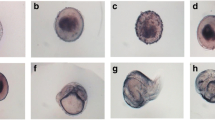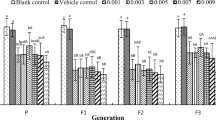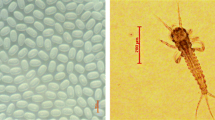Abstract
Pesticide-induced effects in non-target organisms are a worldwide environmental problem and cladocerans have been used as test organisms to quantify the toxicity effects. However, little is known about the true risks of acceptable levels, when non-traditional end points such as sex determination, egg maturation, and teratogenesis are considered. Aims of the present study were to investigate the effects of sublethal concentrations of the fungicide carbendazim taking into account the above-mentioned endpoints and to evaluate their sensitivity to an environmental factor such as temperature, known to influence growth rates and sex determination in cladocerans. We quantified the effect on the life history variables of Moina micrura at two different temperatures using the life table demographic approach, starting with neonates. The median lethal concentration of carbendazim for M. micrura was 0.12 ± 0.01 mg l−1. The impacts of carbendazim were assessed in experiments conducted at 20°C (experiment 1) and 30°C (experiment 3) using four sublethal concentrations of carbendazim (0.01, 0.02, and 0.04) and controls. An additional experiment (experiment 2) on the next generation (F1) was conducted at 20°C, using the offspring of the second clutches of M. micrura from each of the corresponding treatments of the experiment 1. The increase in temperature from 20 to 30°C significantly reduced always the average lifespan and life expectancy at birth, while raised the rate of population increase, net reproductive rate, and reproductive effort, in controls but not in carbendazim treatments. Higher temperature also increased male/female ratio. The patterns of survivorship curves were weakly affected by carbendazim exposure, but increase in concentration of this fungicide reduced offspring production, reproductive rates, and the rate of population increase, more noticeable at the higher temperature. These detrimental effects were much more striking in the F1 experiment, in which females were unable to produce viable offspring in the two highest carbendazim concentrations, although survival and swimming behavior were not significantly affected. This indicates that sensitivity to the toxicant is greater during egg development and that the fungicide acts as an endocrine disruptor. The presence of carbendazim in the medium resulted in higher male production as compared with controls, indicating also its effect on egg development. We also encountered a few individuals, with abnormal sexual secondary characters (males with reduced antennule length, similar to female antennules) at the highest carbendazim concentration. The role of carbendazim on the demography of cladocerans in natural systems, subject to temperature increase, is discussed taking into account the persistence of this chemical and its elevated impact in the successive generations (through the higher sensitivity of the developing eggs to the chemical at high temperatures). Cladoceran bioassays starting with neonates, which usually utilize offspring as sublethal endpoints should include the first generation to evaluate fecundity responses.







Similar content being viewed by others
References
Alfonso, M. T. & M. R. Miracle, 1990. Distribución espacial de las comunidades zooplanctónicas de la Albufera de Valencia. Scientia gerundensis 16(2): 11–25.
Andreu, O. 2008. Evaluación de riesgos ambientales del uso de plaguicidas empleados en el cultivo del arroz en el Parque Natural de La Albufera de Valencia. Ph.D. thesis. Polytechnic University of Valencia.
Banta, A. M., 1939. Studies on the physiology, genetics and evolution of some Cladocera. Carnegie Inst. Washington, Pub. 513, Paper No. 39, Dept. Genetics.
Barata, C., C. Porte & D. Baird, 2004. Experimental design to assess endocrine disrupting effects in invertebrates. A review. Ecotoxicology 13: 511–517.
Bentley, K. S., D. Kirkland, M. Murphy & R. Marshall, 2000. Evaluation of thresholds for benomyl- and carbendazim-induced aneuploidy in cultured human lymphocytes using fluorescence in situ hybridization. Mutation Research 464: 41–51.
Chittapun, S., P. Pholpunthin & L.-O. Sanoamuang, 2009. Diversity and composition of zooplankton in rice fields during a crop cycle at Pathum Thani province, Thailand. Songklanakarin Journal of Science and Technology 31: 261–267.
Daam, M. A., K. Satapornvanit, P. J. Van Brink & A. J. den Nogueira, 2010. Direct and indirect effects of the fungicide Carbendazim in tropical freshwater microcosms. Archives of Environmental Contamination Toxicology 58: 315–324.
Dodson, S. I., C. M. Merritt, J. P. Shannahan & C. M. Shults, 1999. Low exposure concentrations of atrazine increase male production in Daphnia pulicaria. Environmental Toxicology and Chemistry 18: 1568–1573.
Ferreira, A. L. G., S. Loureiro & A. M. V. M. Soares, 2008. Toxicity prediction of binary combinations of cadmium, carbendazim and low dissolved oxygen on Daphnia magna. Aquatic Toxicology 89: 28–39.
Finney, D. J., 1971. Probit Analysis, 3rd ed. Cambridge University Press, Cambridge.
Gama-Flores, J. L., S. S. S. Sarma & S. Nandini, 2007. Exposure time-dependent cadmium toxicity to Moina macrocopa (Cladocera): a life table demographic study. Aquatic Ecology 41: 639–648.
García-García, G., S. Nandini & S. S. S. Sarma, 2006. Turbidity mitigates lead toxicity to cladocerans (Cladocera). Ecotoxicology 15: 425–436.
Haeba, M. H., K. Hilscherová, E. Mazurová & L. Bláha, 2008. Selected endocrine disrupting compounds (vinclozolin, flutamide, ketoconazole and dicofol): effects on survival, occurrence of malesgrowth, molting and reproduction of Daphnia magna. Environmental Science and Pollution Research 15: 222–227.
Ignace, D. D., S. I. Dodson & D. R. Kashian, 2011. Identification of the critical timing of sex determination in Daphnia magna (Crustacea, Branchiopoda) for use in toxicological studies. Hydrobiologia (this volume).
Khalaf, A. N. & A. F. Shihab, 1979. Seasonal variation in the populations of Moina macrocopa Strauss and Moina micrura Kurz (crustacea: cladocera) in Zoafaraniyah pools. Hydrobiologia 62: 75–77.
King, C. E. & M. R. Miracle, 1980. A perspective on aging in rotifers. Hydrobiologia 73: 13–19.
Krebs, C. J., 1985. Ecology; The Experimental Analysis of Distribution and Abundance, 3rd ed. Harper & Row, New York.
Lu, S. Y., J. W. Liao, M. L. Kuo, S. C. Wang, J. S. Hwang & T. H. Ueng, 2004. Endocrine disrupting activity in carbendazim-induced reproductive and developmental toxicity in rats. Journal of Toxicology and Environmental Health 67: 1501–1515.
Morinaga, H., T. Yanase, M. Nomura, T. Okabe, K. Goto, N. Harada & H. Nawata, 2004. A benzimidazole fungicide, benomyl, and its metabolite, carbendazim, induce aromatase activity in a human ovarian granulose-like tumor cell line (KGN). Endocrinology 145: 1860–1869.
Mieiro, C. L., J. A. Cabral & J. C. Marques, 2001. Predation pressure of introduced mosquito fish (Gambusia holbrooki Girard), on the native zooplankton community. A case-study from representative habitats in the lower Mondego river Valley (Portugal). Limnetica 20: 279–292.
Mitchell, S. E., 2001. Intersex and male development in Daphnia magna. Hydrobiologia 442: 145–156.
Nandini, S. & S. S. S. Sarma, 2000. Life table demography of four cladoceran species in relation to algal food (Chlorella vulgaris) density. Hydrobiologia 435: 117–126.
Nandini, S., E. A. Picazo-Paez & S. S. S. Sarma, 2007. The combined effects of heavy metals (copper and zinc), temperature and food (Chlorella vulgaris) level on the demographic characters of Moina macrocopa (Crustacea: Cladocera). Journal of Environmental Science and Health Part A 42: 1433–1442.
Oda, S., N. Tatarazako, H. Watanabe, M. Morita & T. Iguchi, 2005. Production of male neonates in Daphnia magna (Cladocera, Crustacea) exposed to juvenile hormones and their analogs. Chemosphere 61: 1168–1174.
Olmstead, A. W. & G. A. LeBlanc, 2007. The environmental-endocrine basis of gynandromorphism (intersex) in a crustacean. International Journal of Biological Science 3: 77–84.
Oltra, R. & M. R. Miracle, 1992. Seasonal succession zooplankton populations in the hypertrophic lagoon: Albufera of Valencia (Spain). Archives of Hydrobiology 124(2): 187–204.
Sarma, S. S. S. & S. Nandini, 2006. Review of recent ecotoxicological studies on cladocerans. Journal of Environmental Science and Health, Part B 41: 1417–1430.
Sarma, S. S. S., S. Nandini & R. D. Gulati, 2005. Life history strategies of cladocerans: comparisons of tropical and temperate taxa. Hydrobiologia 542: 315–333.
Sokal, R. R. & F. J. Rohlf, 2000. Biometry. W. H. Freeman and Company, San Francisco.
Stanier, R. Y., R. Kunisawa, M. Mandel & G. Cohen-Bazier, 1971. Purification and properties of unicellular blue-green algae (order Chroococcales). Bacteriological Reviews 35: 171–205.
Stearns, S., 1992. The Evolution of Life Histories. Oxford University Press, New York.
Tomlin, C. D. S., 2000. The Pesticide Manual. British Crop Protection Council, Farnham.
Van Wijngaarden, R. P. A., S. J. H. Crum, K. Decraene, J. Hattink & A. van Kammen, 1998. Toxicity of derosal (active ingredient carbendazim) to aquatic invertebrates. Chemosphere 37: 673–683.
Vicente, E. & M. R. Miracle, 1992. The coastal lagoon Albufera de Valencia: an ecosystem under stress. Limnetica 8: 87–100.
Weber, C. I., 1993. Methods for Measuring the Acute Toxicity of Effluents and Receiving Waters to Freshwater and Marine Organisms, 4th edn. United States Environmental Protection Agency, Cincinnati, Ohio, EPA/600/4-90/027F.
Acknowledgments
Professor S. Dodson was an outstanding scientist whose ideas given so enthusiastically in the meetings as well as his interesting publications on cladoceran biology and ecotoxicology have been a guiding force for us, especially while conducting this study. We would like to thank Oscar Andreu for providing the fungicide carbendazim, measurements of actual concentrations, and advices about its use. We are grateful to R.D. Gulati for improving our presentation and to Ricard Miracle for his help in the elaboration of the table and some figures. Two of us (SN and SSSS) thank the National Autonomous University of Mexico for sabbatical permission through the PASPA scheme. MRM acknowledges the funding by MCINN (Spanish Ministry of Science and Innovation) through the project CGL2009-12229.
Author information
Authors and Affiliations
Corresponding author
Additional information
Guest editors: H. J. Dumont, J. E. Havel, R. Gulati & P. Spaak / A Passion for Plankton: a tribute to the life of Stanley Dodson
Rights and permissions
About this article
Cite this article
Miracle, M.R., Nandini, S., Sarma, S.S.S. et al. Endocrine disrupting effects, at different temperatures, on Moina micrura (Cladocera: Crustacea) induced by carbendazim, a fungicide. Hydrobiologia 668, 155–170 (2011). https://doi.org/10.1007/s10750-011-0638-z
Received:
Accepted:
Published:
Issue Date:
DOI: https://doi.org/10.1007/s10750-011-0638-z




